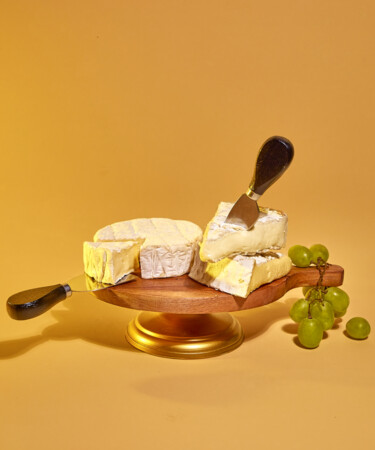Back in the days when I worked as a cheesemonger, customers often used the name “Brie” to refer to any soft-ripened cheese with a white, bloomy rind. While that’s technically incorrect, it’s easy to understand why that mistake is so common, especially when it comes to Camembert.
At first glance, the beloved French cheese looks like a smaller version of Brie. Specific versions of both cheeses — yes, it’s complicated because there are different forms of each — also have protected Appellation d’Origine Contrôlée (AOC) status under French law, which safeguards traditional agricultural products like cheese and specifies manufacturing regions, milk types, aging guidelines, craftsmanship, and more. But once you dive more deeply into the world of bloomy-rind cheeses, you’ll realize they possess subtle differences, and that they aren’t exactly interchangeable. So before you head to your local cheese shop or even the neighborhood supermarket, read up on these iconic cheeses.
Brie de Meaux
As one of the oldest and most traditional types of Brie, many cheese connoisseurs consider this unpasteurized cheese originating from the Île-de-France region outside Paris to be the “true” version. Its history dates back to the Middle Ages when royalty and the upper echelons of society enjoyed it. Brie de Meaux (AOC), one of France’s most famous cheeses, stays true to those historical roots with a centuries-old production process.
To meet AOC standards, Brie de Meaux is carefully crafted in specific parts of the Île-de-France region, using raw cow’s milk and a precise cheesemaking process that involves hand-molding and aging for a minimum of four weeks. The resulting wheels weigh around six pounds each and have an average diameter of 14 to 15 inches. With its elegant appearance, luscious texture, and mushroomy taste, Brie de Meaux easily outshines regular supermarket Brie in terms of flavor and texture — but more on that later.
It’s also worth mentioning that Brie de Melun, another AOC-protected variety that is less well-known around the world, is also made with raw cow’s milk and offers a smaller size, firmer texture, and even more robust and intense flavor.
Brie
If you see a cheese labeled “Brie” in the U.S., to the untrained eye, it might appear indistinguishable from an authentic Brie de Meaux. But there are some major differences: Bloomy-rind cheeses like Brie are usually aged for less than 60 days, making authentic Brie de Meaux and Brie de Melun — both crafted from raw milk — illegal for import in the U.S., according to Food and Drug Administration (FDA) regulations. But the rise of industrialized cheesemaking and international demand has made similar cheeses, or at least lookalikes, more widely available. Cheeses labeled as “Brie” stateside may vary significantly in flavor, texture, and ingredients due to the lack of specific regulations governing what kind of product can carry the name. As a result, your average supermarket Brie tends to be milder, lacking the tanginess and fruitiness of a genuine Brie de Meaux. However, like Brie de Meaux, it is often sold as a wedge from a larger wheel.
A handful of small American producers are crafting unique, bloomy-rind cheeses in different shapes, sizes, and even using goat’s milk instead of cow’s milk and labeling them as “Brie” due to the name’s widespread recognition. While it may seem like a marketing ploy, it doesn’t necessarily take away from the quality; many of these cheeses are quite good.
Camembert de Normandie
Camembert cheese traces its roots back to Normandy, where legend has it that a farmer named Marie Hamel learned the art of cheesemaking from a priest seeking refuge during the French Revolution. Grateful for her hospitality, he shared with her the secrets of crafting a Brie-like cheese adapted to the local region.
Like Brie de Meaux, traditional Camembert (explicitly known as Camembert de Normandie) holds an esteemed AOC status. It must be produced in Normandy using raw cow’s milk, specific lactic starters, and traditional methods. This cheese, which ripens for at least three weeks, boasts a bloomy white rind, creamy texture, and a rich, earthy flavor infused with hints of truffle and barnyard aromas. Despite worldwide popularity leading to imitations, nothing compares to a genuine Camembert de Normandie.
Camembert
The Camembert you find at your local grocery store probably shares a similar flavor profile with the Brie sold alongside it, but with a slightly more intense and earthy taste. The main distinguishing factor is the size and format: Camembert is usually much smaller, and is typically sold whole in a charming wooden box.
While traditional Camembert de Normandie made with raw milk is unavailable in the U.S., some small French producers export pasteurized versions of Camembert (and Brie, for that matter) that come close to the original. However, you won’t likely find them in a regular supermarket. For the best options, seek recommendations from knowledgeable cheesemongers at specialty cheese shops.
The bottom line? Don’t fixate too much on the label when buying Camembert or Brie stateside. Instead, explore different options and flavors to find the one that best suits your taste preferences.
Triple Cream Cheeses
While exploring this corner of the cheese world, it’s worth venturing into the realm of triple crème varieties, which are often confused with Brie due to their circular shape and bloomy white rinds. These decadent cheeses reach unparalleled creaminess because they are enriched with, well, cream, and boast a minimum fat content of 75 percent. Three well-known examples of these luxurious triple crème cheeses are St. André, Brillat-Savarin, and Cremeaux de Bourgogne, each offering unique flavor profiles complemented by their velvety textures and buttery mouthfeel.
